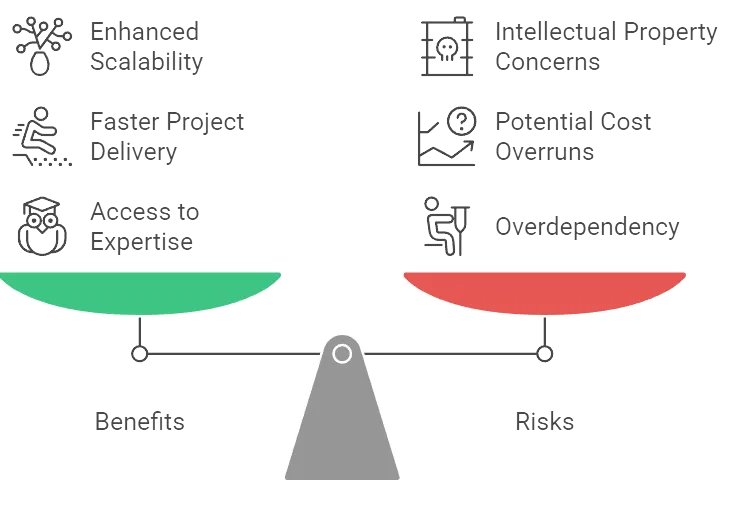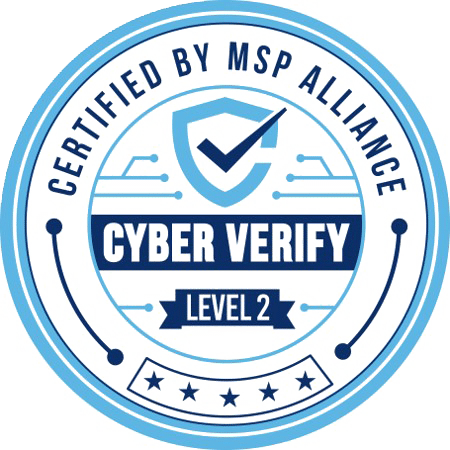Technology staff augmentation is a service that allows businesses to temporarily add skilled IT professionals to their teams instead of hiring full-time employees. You would partner with third-party staff augmentation IT companies to access qualified personnel on a short-term or project-based basis.
| “Good employees can be hard to find, but working with a partner who provides augmented IT staff means your hunt is already over.” – Brian Leger, Co-Founder of InfoTECH Solutions |
IT staff augmentation gives you quick access to highly skilled technology experts during periods of high demand without going through lengthy hiring processes. It may also be a way for you to bring in professionals with niche technical skills that are not easy to find in the talent market.
Of course, augmented staff isn’t the right choice for every organization. That’s why this article will explore the IT staff augmentation model in more detail so you can decide whether or not it’s a good choice for you.
How is IT Staff Augmentation Different Than IT Outsourcing?
IT staff augmentation is best suited for short-term, skill-specific needs where the organization wants to maintain control over their work. IT outsourcing is ideal for delegating broader IT responsibilities to a specialized provider, often with the goal of reducing operational burdens or costs.
That’s because IT staff augmentation involves temporarily hiring external IT professionals to fill specific roles. Comparatively, an IT outsourcing provider assumes full responsibility for the delivery of the specified services. As a result, organizations using IT staff augmentation retain direct oversight while those who outsource IT may not.
Some organizations aren’t fully comfortable with the lack of control that may come with IT outsourcing. However, around 45% of business leaders find that leaving their IT tasks to an external team of professionals is the best way to save time and money. The choice truly depends on you.
What is The IT Staff Augmentation Process Flow?
1. Partner Selection
Choose a staff augmentation provider with expertise in your industry. Look for one with a strong track record, compliance standards, and the ability to scale. Selecting the right partner ensures you have access to a reliable talent pool.
2. Candidate Evaluation
Review the candidates provided by your partner. Conduct interviews, technical assessments, and background checks. Make sure to assess their technical skills and how well they fit with your team. While your partner should only offer you qualified candidates, it’s a good idea to verify the people they suggest before signing any contracts.
3. Onboarding & Integration
Introduce the newly augmented team members to your in-house staff, workflows, and tools. Share your company policies and security protocols. Provide the resources they need to start working effectively. This step helps them integrate quickly and contribute right away.
4. Performance Management
Track the work of the augmented staff to ensure they meet your goals. Provide regular feedback and address any concerns immediately. Keeping open communication ensures their work stays aligned with your expectations.
5. Transition or Offboarding
When the project ends, organize a clear offboarding process. Ensure they complete all tasks and transfer knowledge to your team. Review the success of the engagement to identify areas for improvement. This is also when you may want to evaluate whether to work with that same contractor again in the future.
What Are The Common IT Staff Augmentation Pricing Models?
Just as managed IT services come with varying pricing models, so do IT staff augmentation services. Like with managed services, the exact price will depend on who you partner with. Therefore, it’s hard to give you an exact average. However, here is an overview of the various pricing models that may come with IT staff augmentation.
| Pricing Model | Description | Pros | Cons |
| Hourly Rate | Pricing based on the number of hours worked by the augmented team works. | Flexible and cost-effective for short-term needs. | Costs can add up for long-term or extensive projects. |
| Monthly Retainer | A fixed monthly fee for ongoing access to a set number of resources or hours. | Predictable costs and consistent support. | May lead to underutilization if hours or resources are not fully used. |
| Project-Based Pricing | A fixed price is set for the completion of a specific project. | Clear budget expectations and scope clarity. | Less flexibility for changes or adjustments mid-project. |
| Dedicated Resource Model | Full-time access to dedicated resources for a specified time period. | High control and direct management of resources. | Higher upfront costs and requires clear task delegation to maximize value. |
| Output-Based Pricing | Costs are determined by the deliverables or outcomes achieved rather than by time or resources used. | Encourages efficiency and measurable results. | Requires detailed agreements to avoid disputes over deliverables or quality. |
Risks & Benefits of Technology Staff Augmentation
Benefits
1. Access to Specialized Expertise
CloudSecureTech points out that 90% of organizations are predicted to face an IT skill shortage by 2026. IT staff augmentation helps you avoid becoming one of them. Businesses gain access to skilled professionals who specialize in specific areas without having to spend months searching for them.
2. Faster Project Delivery
Project team augmentation means more efficient project management. That’s because additional resources ease workloads and streamline workflows. The result is faster project deliveries and fewer missed deadlines.
3. Enhanced Scalability
Staff augmentation lets businesses adjust their workforce size based on current needs. Therefore, you can avoid overstaffing during slower periods and maintain productivity during peak demand.

Potential Risks & How to Mitigate Them
1. Overdependency
Over-reliance on temporary staff can weaken the development of internal expertise. This happens when critical skills remain outsourced instead of being built internally. Mitigate this by balancing external talent with upskilling internal employees.
2. Intellectual Property Concerns
Temporary staff may access sensitive information. So, you may be concerned about related cybersecurity risks or IP data leaks. You can mitigate this by enforcing strict non-disclosure agreements and controlling access to sensitive data.
3. Potential Cost Overruns
Costs can rise when expectations or budgets are not clearly defined upfront or if projects run longer than planned. That’s why it’s important to have set project requirements before you onboard augmented staff. Also, maintain oversight of resource usage to prevent scope creep.
Technology Staff Augmentation Alternatives
If you need the IT skill set that technology staff augmentation provides but are apprehensive about the service model, you have other options. Here are some of them and when they may be the best choice for you.
1. Managed IT Services
Working with a managed IT service provider (MSP) means receiving comprehensive technology support by outsourcing your IT operations to a professional provider. About 68% of organizations currently use this particular service model. These providers handle everything from day-to-day technical issues to long-term IT strategy planning.
This option may be your best alternative if:
- You want proactive IT management and 24/7 support.
- You prefer predictable monthly costs for IT services.
- You need expertise across various IT functions without hiring in-house staff.
2. Upskilling In-House Staff
Investing in IT training for your current employees helps build in-house expertise to address your technology needs. You enroll your existing staff in specialized training programs or certifications to develop the skills required for your IT challenges.
This option may be your best alternative if:
- You have capable employees who need upskilling for specific tasks.
- You prefer to rely on your existing team instead of outsourcing.
- You are ready to invest time and money into staff development.
| Learn More About How You Can Enhance Your IT Capacity How to Navigate a Successful IT Integration in Mergers & Acquisitions 7 IT Procurement Best Practices You Need to Follow Managed Services vs Staff Augmentation: A Detailed Comparison |
3. Hiring New Employees
An in-house IT team gives you direct control over your IT environment. This is the most straightforward way to expand your team’s capabilities if you have the time and money to invest in recruitment, salaries, and benefit packages.
This option may be your best alternative if:
- You want full control over your IT operations.
- Your organization requires onsite IT presence at all times.
- You are ready to invest in hiring, training, and managing a team.
4. Freelancers
Freelance IT specialists provide on-demand expertise for specific tasks or short-term needs without a long-term commitment. You hire independent contractors with the technical skills required for your specific IT need – and they work on a task-by-task basis or on a time-limited contract.
This option may be your best alternative if:
- You have a well-defined, temporary IT need.
- You prefer a flexible, low-commitment service model.
- Your project doesn’t require a large team or full-time availability.
5. Selective IT Outsourcing
You can be selective about IT outsourcing. Instead of leaving all of your IT tasks to a third party, you may contract a vendor to handle a particular aspect of your IT needs. This allows you to offload specific responsibilities while maintaining control over other parts of your IT operations.
This option may be your best alternative if:
- You want to offload specific IT responsibilities but keep overall control of your IT strategy.
- Your organization needs specialized expertise for a defined function.
- You aim to reduce costs for specific IT operations without a full-service contract.
| Ask Our Louisiana Team About Your IT Needs | ||
| New Orleans | Baton Rouge | Lafayette |
Augment Your IT Staff or Choose Managed Services With InfoTECH Solutions
If you’re interested in fully outsourcing certain functions and augmenting IT staff for others, you don’t need to rely on multiple vendors. All you need to do is work with InfoTECH Solutions. Our team has over 17 years of experience helping clients in a wide variety of industries, and they’re ready to help you too.
Reach out to us today to get started.



